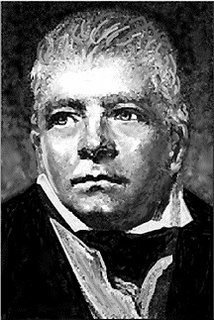Sir Walter Scott (1771 - 1832)

Sir Walter Scott was born on August 15, 1771 in Edinburgh, Scotland. A writer, poet and born storyteller, he was one of the greatest historical novelists Scotland has seen.
The son of a solicitor, Walter, and professor of medicine, Anne, Walter Scott was one of eleven children in the family, although six of them died in infancy. He contracted polio while very young and this left him permanently lame in his right leg, but he grew up to be over six feet tall. In 1775 the family moved to a more spacious house in George Square, where Scott was to live until 1797.
Scott's interest in old Border tales and ballads was keen and he devoted much of his time exploring the Border countryside. In his early years, Scott spent a lot of time in Sandy-Know, the residence of his paternal grandfather. There his grandmother told him tales of old heroes.
At the age of eight he returned to Edinburgh and attended Edinburgh High School from 1779 to 1783. He went on to study Arts and Law at Edinburgh University between 1783 and 1786 and after a disruption caused by illness, resumed and completed his studies between 1789 and 1792.
Scott was apprenticed to his father in 1786 and in 1792 he qualified as an advocate. Scott married Margaret Charlotte Charpentier, daughter of Jean Charpentier of Lyon, in France in 1797 and together they had five children. In 1799 he was appointed sheriff depute to the county of Selkirk.
In 1802 Scott's first major work was published, Minstrelsy Of The Scottish Border. As a poet, Scott rose to fame with the publication of The Lay Of The Last Minstrel in 1805, about an old border country legend. He had burned its first version, when his friends did not like it, but it became a huge success and helped establish his name.
In 1806 Scott became clerk to the Court of Session in Edinburgh, though this work took little time and for six months of the year he was free to write. He spent long holidays at Ashestiel on the River Tweed and to increase his income, he started a printing and publishing business with his friend James Ballantyne.
The firm ran into financial difficulties however, and Scott spent his time labouring hard for his publishers. Scott also expanded his Abbotsford estate during these years, but it was not until 1826 when things finally crashed. He accepted all Ballantyne's debts and decided to pay them off with his writings, to the tune of £130,000 (millions today).
Scott published all his novels anonymously. Initially this may have been a precaution after the failure of Waverley in 1814, which dealt with the 1745 rebellion, but even after it did become successful, Scott enjoyed prolonging the mystery of his identity. It soon became an open secret, but it was not until February 1827 that he officially "revealed" himself, at a public dinner in Edinburgh.
Scott wrote profusely from 1815 to 1819, publishing 9 novels, among them the famous Rob Roy in 1817, which sold out its edition of 10,000 copies in two weeks, The Heart Of Midlothian in 1818 was and Ivanhoe in 1819.
In the 1820’s eight more titles came, but after the company folded in 1826 the author's anonymity was destroyed, and he was finally exposed to the general public as Sir Walter Scott.
In 1820 he was created a baronet and a few years later he founded the Bannatyne Club, which published old Scottish documents. Prior to the publication of his nine-volume work, Life Of Napoleon, Scott had started to keep a journal, recording in it his weakening spirit and deteriorating health.
His wife, Lady Scott, died in 1826, and Scott himself suffered a stroke in 1830. The following year he sailed to Italy then Malta, where he wrote a novel and a short story. He returned to England in 1832, and collapsed and died at Abbotsford on September 21st. Scott was buried beside his ancestors in Dryburgh Abbey and from the profits of his writings, all his debts were paid off.
Sir Walter Scott's influence as a novelist was profound. He established the form of the historical novel and his work inspired many great writers in his wake. His work has been analysed and criticised by many groups throughout history, from European Marxist critics, to scholars, philosophers and writers.
Edinburgh's Scott Monument, built in 1844, the nearby Waverley Station and numerous public houses, bear witness to Scott’s extraordinary status in Victorian Britain. For it was Sir Walter Scott who largely defined Scotland's image in the 20th century.

0 Comments:
Post a Comment
<< Home